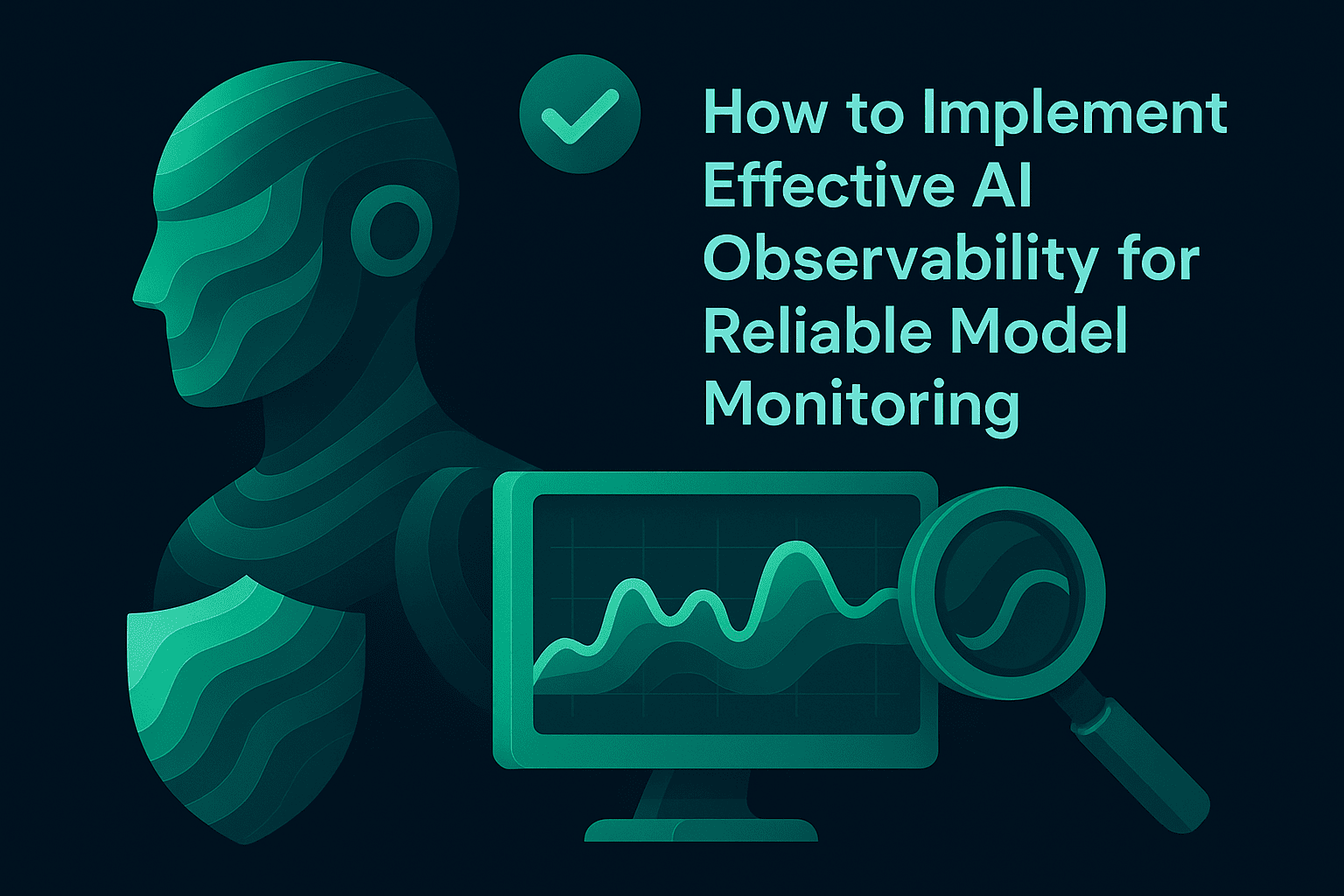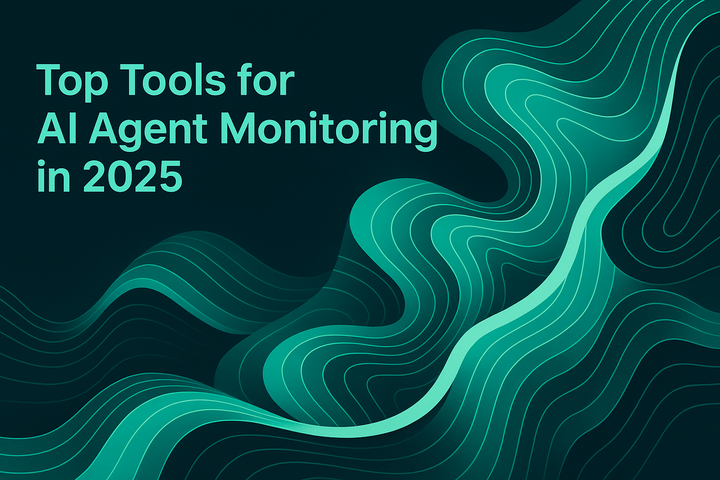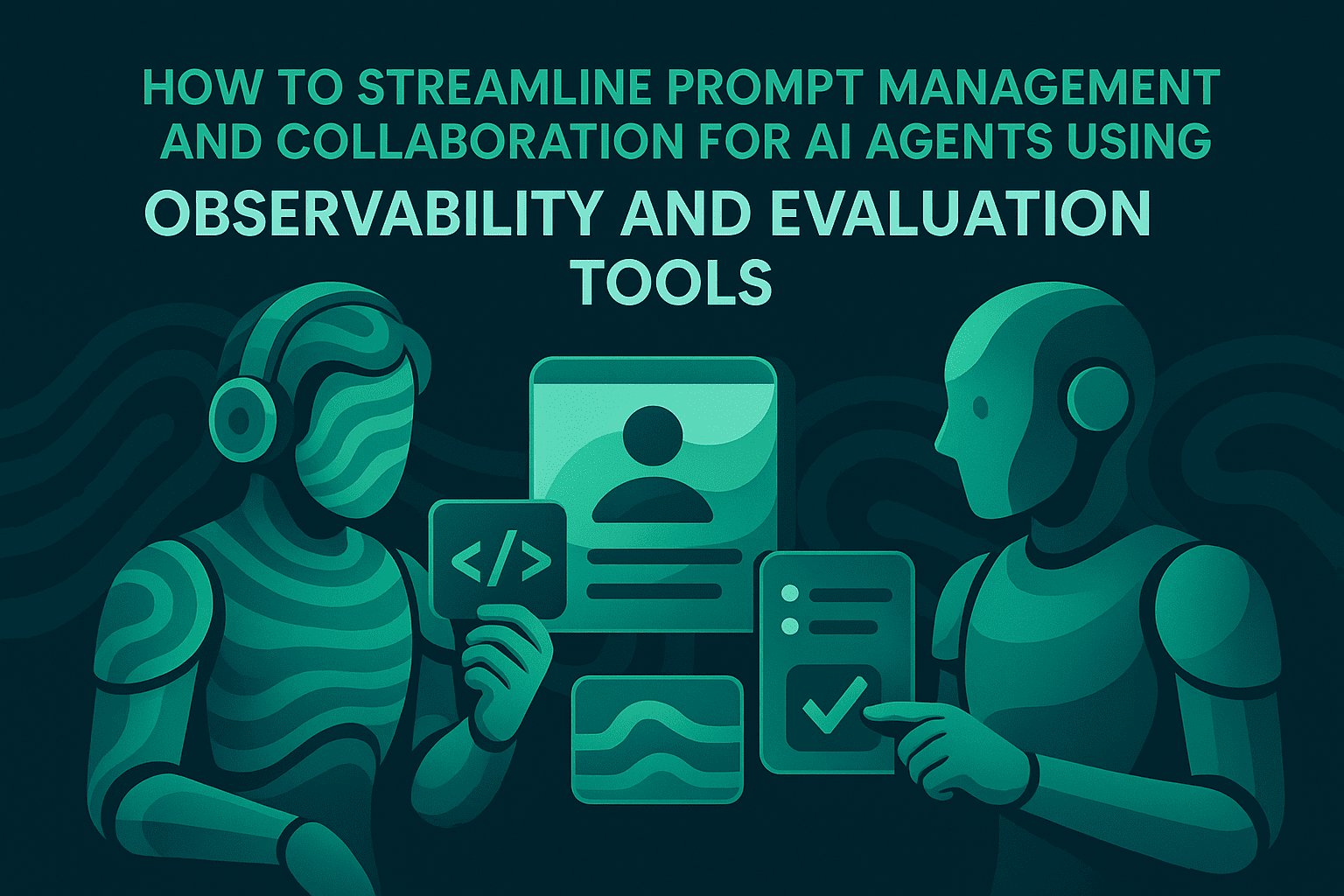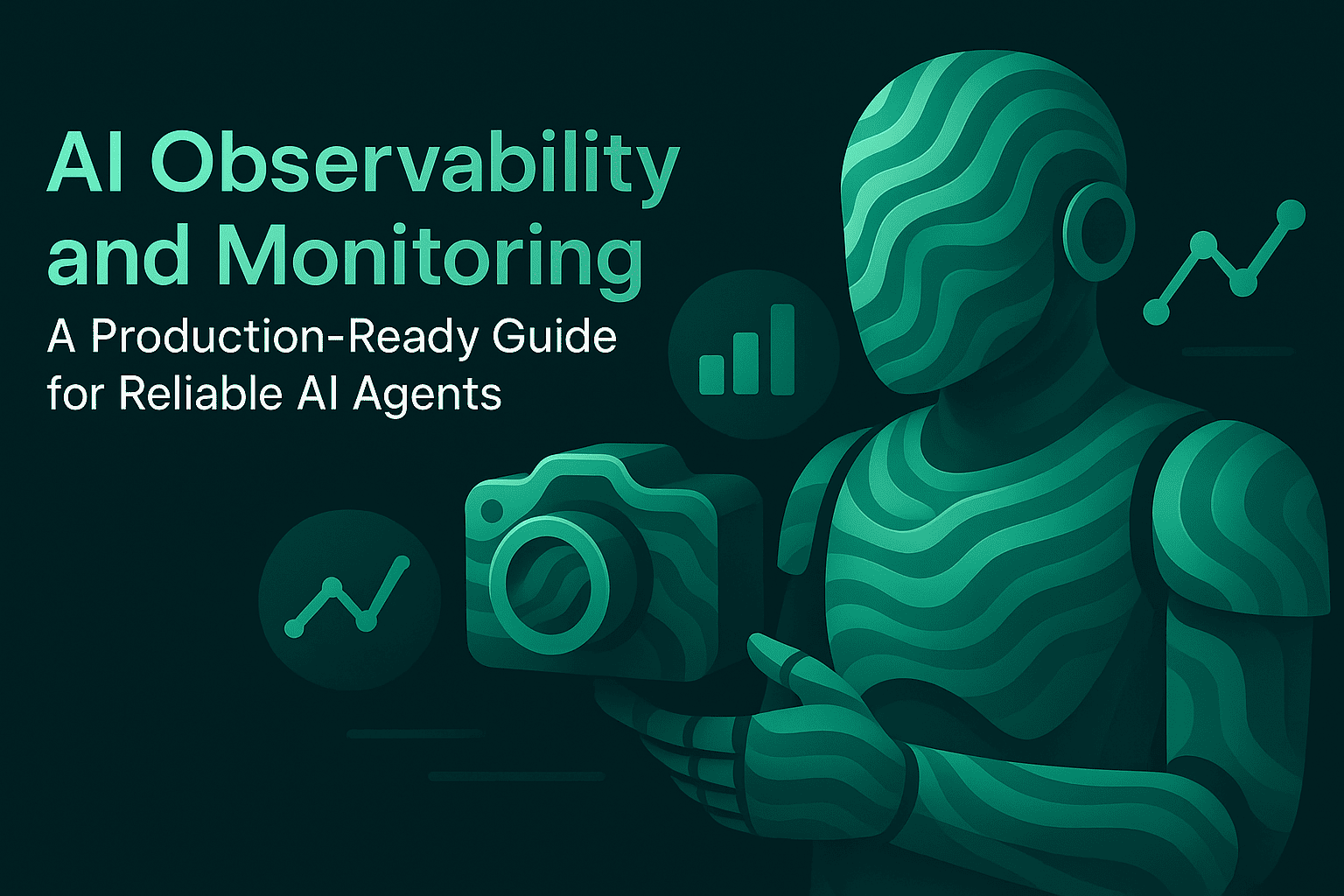How to Implement Effective AI Observability for Reliable Model Monitoring

AI applications are now complex, multi-agent systems that span prompts, retrieval-augmented generation (RAG) pipelines, tool calls, and model routers across multiple providers. Reliability in such systems is not a function of any single model; it is the result of disciplined AI observability: structured visibility into real-time behavior, quality metrics, and trace-level root-cause analysis. This guide provides a pragmatic blueprint for implementing model monitoring and LLM observability aligned to production needs, using proven patterns that scale from single-agent chatbots to multimodal voice agents and autonomous copilots.
Why AI Observability Matters in Production
AI systems fail in non-obvious ways: silent prompt regressions, retrieval drift, brittle tool integrations, provider outages, and hallucination detection failures at edge cases. These are compounded by business constraints—latency SLAs, cost ceilings, governance, and compliance. Effective model observability solves for:
- End-to-end visibility with distributed tracing at session, trace, and span granularity, so teams can pinpoint failures across prompts, RAG steps, tool calls, and model invocations.
- Quantitative llm evaluation and automated ai monitoring against business-defined quality criteria, so “working” systems stay aligned with product outcomes.
- Repeatable agent debugging workflows that reproduce failures, validate fixes, and prevent regressions with continuous agent evaluation and curated datasets.
- Operational resilience via ai gateway control planes, automatic failover, load balancing, and semantic caching, so reliability and cost are first-class citizens.
Maxim AI’s Agent Observability suite provides unified ai tracing, alerting, and in-production llm monitoring with quality checks and curated datasets, designed for teams shipping real agents at scale. See: Agent Observability.
Core Pillars of AI Observability
1) Tracing: Capture Every Decision, Tool Call, and Hand-off
Observability starts with granular agent tracing and llm tracing. You must capture:
- Session and conversation context: user persona, history, and current intent.
- Span-level detail: prompt inputs, model outputs, RAG retrievals, tool requests and responses, and intermediate reasoning artifacts.
- Versioning hooks: prompt versioning, dataset versions, and evaluator versions for reproducibility.
- Cross-provider metadata: which model, which provider, latency, cost, and gateway routing decisions.
Maxim’s observability uses distributed tracing across multi-agent workflows, with logs that can be inspected and filtered by custom dimensions, then correlated with evaluations and alerts. Explore the product: Agent Observability.
2) Evals: Quantify Quality with Automated and Human Evals
Qualitative inspection is not enough. Systematic evals quantify quality at scale:
- Deterministic checks: regex or rule-based validators for compliance, structured outputs, and guardrails.
- Statistical evaluators: precision/recall, NDCG for retrieval, or cost/latency distributions to monitor performance constraints.
- LLM-as-a-judge evaluators: useful for nuanced criteria, augmented with spot-checking and human review to minimize bias and drift.
- Human-in-the-loop: last-mile agent evaluation for subjective correctness, tone, and UX.
Maxim provides a unified framework for machine and human evaluations, configurable at session, trace, or span level. Learn more: Agent Simulation & Evaluation.
3) Simulation: Reproduce Failures and Validate Fixes
Production logs reveal symptoms; ai simulation reproduces and fixes root causes. With simulation:
- Generate scenario matrices across personas, inputs, and environments.
- Trace and evaluate trajectory quality, did the agent complete the task end-to-end?
- Agent debugging becomes reproducible: rerun from any step, apply changes to prompts/tools, and measure impact with rag evals, chatbot evals, or copilot evals.
Maxim’s Simulation supports hundreds of scenarios and re-runs for deterministic debugging. See: Agent Simulation & Evaluation.
4) Experimentation: Safe Velocity via Prompt Management
Pre-release prompt engineering needs first-class prompt management and experimentation:
- Organize and version prompts in UI.
- Compare output quality, cost, and latency across prompts, models, and parameters.
- Connect to databases, RAG pipelines, and prompt tools without code changes.
Maxim’s Playground++ accelerates iteration and controlled deployment of prompt variants. Explore: Experimentation.
Reference Architecture for AI Observability
A robust production architecture combines observability and control-plane features:
- Logging & Tracing Layer: Capture session, trace, and span-level data from agents, RAG, and tools. Stream structured logs to observability backends for real-time inspection.
- Evaluation Layer: Attach evaluators at multiple levels—response-level, step-level RAG, and final conversation-level outcomes. Blend deterministic, statistical, and LLM-as-a-judge evaluators with human review.
- Gateway Control Layer: Use an llm gateway with automatic fallbacks, load balancing, and semantic caching to route requests across providers, minimize downtime, and control cost.
- Data Engine: Curate and evolve datasets from production logs for targeted evals and fine-tuning. Maintain splits and coverage across personas, intents, and edge cases.
- Alerting & Dashboards: Configure real-time alerts tied to evaluators and system metrics. Create custom dashboards that slice insights across any dimension relevant to your business.
Maxim provides native integrations for each layer, so engineering and product teams collaborate in one place without brittle glue. See: Agent Observability and Agent Simulation & Evaluation.
Implementation Guide: Step-by-Step
- Instrument Tracing at the Right GranularityImplement span-level tracing in your agents. Log prompt templates with prompt versioning, inputs, outputs, and tool call metadata. Capture RAG steps: query formation, retrieved documents, and citation sources. Establish a consistent trace schema across apps so agent observability scales with clarity. Reference: Agent Observability.
- Attach Evals Early and OftenStart with deterministic checks (output schemas, safety constraints), add retrieval metrics (precision/recall, coverage), then layer llm evaluation and human review for nuanced correctness. Configure automated evaluations for in-production requests to catch regressions in minutes, not days. Reference: Agent Simulation & Evaluation.
- Build Simulation Suites from Real LogsUse production logs to define simulation scenarios for your top flows—task completion benchmarks, guardrail tests, and edge-case reproductions. Rerun from any step to validate changes. Keep simulations and evals versioned to track improvements over time. Reference: Agent Simulation & Evaluation.
- Establish a Gateway with Reliability ControlsDeploy a high-performance ai gateway with unified, OpenAI-compatible APIs for multi-provider access. Configure automatic fallbacks for zero-downtime, load balancing across keys/providers, and semantic caching to reduce cost and latency. See Bifrost’s docs:
- Unified interface: Model-agnostic Unified Interface
- Multi-provider support: Provider Configuration
- Automatic fallbacks & load balancing: Fallbacks
- Semantic caching: Semantic Caching
- Observability & tracing: Observability Features
- Create Dashboards and Alerts Tied to Business OutcomesMetrics must map to value. Define dashboards for:
- Quality: task success, correctness, citation integrity, safety violations.
- Cost: per-request, per-session, per-customer budgets.
- Performance: latency percentiles, time-to-first-token, throughput.
- Reliability: provider uptime via fallback trigger rates, cache hit ratios, rate limit events.
Set alerts on trend shifts or threshold breaches—e.g., a drop in rag evaluation precision, spikes in voice monitoring latency, or increased fallback usage.
- Close the Loop with Data CurationContinuously convert logs and eval outputs into curated datasets for re-testing and fine-tuning. Maintain stratified splits by persona and task type to avoid overfitting. Use human feedback where it adds nuance, especially for tone-critical voice evals and customer-facing flows. Reference: Agent Observability.
Key Metrics to Track for Reliable Model Monitoring
- Quality Metrics: task completion rate, answer correctness, citation fidelity, harmful content rate, structured output validity.
- RAG Metrics: retrieval precision/recall, coverage by persona/intent, retrieval latency, stale-doc detection.
- Operational Metrics: p50/p95/p99 latency, throughput, error rates, fallback invocation rates, cache hit ratios.
- Cost & Governance: cost per request/session/customer, quota consumption, rate limit incidents, access control violations.
- Voice Agent Metrics: ASR accuracy, voice tracing steps, user turn success, sentiment/tone alignment, barge-in handling performance.
These roll up to holistic ai reliability: systems that maintain consistent outcomes under load, across providers, and through continuous iteration.
Common Pitfalls and How to Avoid Them
- Under-instrumented Traces: Without span-level detail on prompts, tools, and retrieval, teams chase symptoms. Instrument all hops and maintain strict prompt management and versioning.
- Eval Drift: Over-reliance on generic llm-as-a-judge without periodic human calibration yields misaligned judgments. Blend deterministic checks, statistical metrics, and human review for important flows.
- Uncontrolled Provider Variability: Switching models blindly causes regressions. Use an llm gateway with llm router and governed model router policies, plus automatic fallbacks and load balancing to stabilize performance. See: Provider Configuration and Fallbacks.
- No Simulation Loop: Teams fix one-off bugs without validating across personas and scenarios. Establish simulation suites and re-run from any step to ensure changes generalize. Reference: Agent Simulation & Evaluation.
- Data Chaos: Logs and evals never become curated datasets. Use a Data Engine approach to import, enrich, and maintain splits for measurable improvements in ai quality.
How Maxim AI Accelerates Observability and Reliability
Maxim’s full-stack approach meets teams where reliability actually lives—in the seams of experimentation, simulation, evaluation, and production observability:
- Experimentation: Manage and compare prompts, models, and parameters, versioned in UI for high-velocity iteration. See: Experimentation.
- Simulation: Run hundreds of scenario tests across personas; re-run from any step to reproduce bugs and verify fixes. See: Agent Simulation & Evaluation.
- Evaluation: Deploy machine and human evaluators at trace and span levels; visualize runs on large test suites for controlled releases. See: Agent Simulation & Evaluation.
- Observability: Monitor live logs, resolve issues with alerts, and curate datasets from production with distributed tracing and periodic quality checks. See: Agent Observability.
- Bifrost AI Gateway: Unify 12+ providers via an OpenAI-compatible API; get automatic failovers, load balancing, semantic caching, and built-in observability. Explore: Zero-Config Startup, Unified Interface, and Observability.
Together, these capabilities enable engineering and product teams to collaborate seamlessly, move faster without compromising safety or cost, and deliver dependable agent monitoring at scale.
Example: Production RAG Agent with Voice Support
Consider a multimodal support assistant that handles text and voice:
- Use Bifrost’s llm gateway for routing and automatic fallbacks to handle provider issues without downtime. Reference: Fallbacks.
- Instrument rag observability at span level: log query construction, retrieved docs, and citation mappings. Evaluate retrieval precision/recall and end-to-end task completion via rag evals and conversation-level agent evals. Reference: Agent Simulation & Evaluation.
- Add voice observability: trace ASR outputs, latency, and barge-in handling. Run voice evals for accuracy and tone alignment.
- Enforce prompt versioning and prompt management in Experimentation for safe iterations across personas.
- Configure production alerts: retrieval drift, increased fallback rate, rising latency, or drops in correctness. Investigate via agent tracing dashboards and simulate the failing path to validate fixes. Reference: Agent Observability.
Conclusion: Make Reliability a Product Capability, Not a Wish
Reliable AI applications do not emerge from single-model upgrades. They come from robust ai observability, measurable ai evaluation, disciplined agent debugging, and operational control via an llm gateway. When teams instrument trace-level visibility, run continuous evals, simulate real scenarios, and govern routing with fallbacks and caching, they ship agents that stay reliable under real-world conditions.
Maxim AI’s platform was built for this lifecycle, so your team can move 5x faster without sacrificing correctness, safety, or cost. Explore the stack here:
- Agent Observability
- Agent Simulation & Evaluation
- Experimentation
- Bifrost Gateway: Unified Interface, Provider Configuration, Fallbacks, Semantic Caching, Observability
Ready to see it in action? Book a demo: Maxim Demo or get started now: Sign Up.


